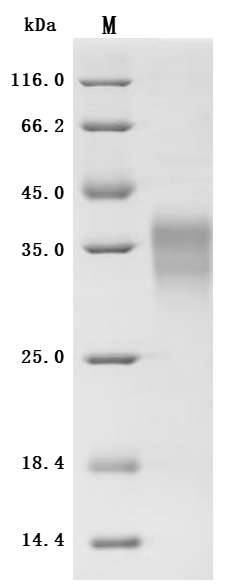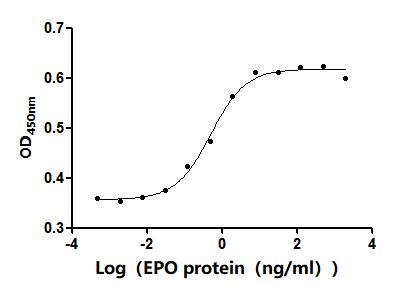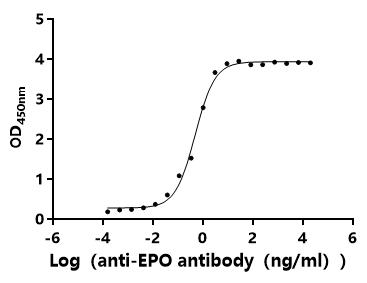The recombinant human EPO protein is an active glycoprotein expressed in mammalian cells, comprising amino acids 28 to 193 of the native erythropoietin sequence. It is engineered with a C-terminal 10xHis tag to aid purification and downstream applications. This protein demonstrates a purity level above 90%, as verified by SDS-PAGE. It has been validated as highly potent to stimulate TF-1 cell proliferation in a dose-dependent manner, with an ED50 of 0.3534 to 0.7096 ng/mL.
Erythropoietin (EPO) is a glycoprotein hormone primarily produced in the kidneys that plays a crucial role in erythropoiesis, the process of red blood cell production. Human EPO functions by binding to the erythropoietin receptor (EpoR), which is expressed in various tissues, including the bone marrow and endothelial cells, promoting the survival and proliferation of erythroid progenitor cells [1][2]. The EPO is inducibly synthesized by hypoxia, allowing the body to adapt to low oxygen levels by increasing red blood cell production, thereby enhancing oxygen transport to tissues [3][4].
EPO is increasingly recognized for its neuroprotective properties, as it can cross the blood-brain barrier and protect neuronal cells from damage due to ischemia and inflammation [5][6]. For example, EPO has been shown to protect retinal ganglion cells from damage induced by various stressors, demonstrating its potential in treating neurodegenerative conditions [7]. Furthermore, research has indicated that EPO might facilitate skeletal muscle repair through autocrine mechanisms, particularly in response to hypoxic conditions [8].
The physiological repercussions of EPO signaling are mediated by activating intracellular signaling pathways. Upon binding to EpoR, EPO activates the JAK2 pathway, phosphorylating downstream targets like STAT proteins and PI3K, which are critical for cell survival and proliferation [4][9]. Moreover, EPO's interaction with receptors in non-erythroid tissues suggests its involvement in other biological processes, including tissue repair and angiogenesis [9][10]. Recent studies have revealed that it can significantly influence endothelial cell behavior and promote tissue remodeling during hypoxic states, further underscoring its multifunctional nature [9][10].
References:
[1] L. Wang, L. Di, & C. Noguchi. Erythropoietin, a novel versatile player regulating energy metabolism beyond the erythroid system. International Journal of Biological Sciences, vol. 10, no. 8, p. 921-939, 2014. https://doi.org/10.7150/ijbs.9518
[2] E. Gao and W. Koch. Is erythropoietin behind maladaptive anemic heart failure? Ajp Heart and Circulatory Physiology, vol. 296, no. 3, p. H559-H560, 2009. https://doi.org/10.1152/ajpheart.00045.2009
[3] C. Moon, M. Krawczyk, et al. Erythropoietin, modified to not stimulate red blood cell production, retains its cardioprotective properties. Journal of Pharmacology and Experimental Therapeutics, vol. 316, no. 3, p. 999-1005, 2006. https://doi.org/10.1124/jpet.105.094854
[4] W. Mao, C. Iwai, J. Liu, S. Sheu, M. Fu, & C. Liang. Darbepoetin alfa exerts a cardioprotective effect in autoimmune cardiomyopathy via reduction of er stress and activation of the pi3k/akt and stat3 pathways. Journal of Molecular and Cellular Cardiology, vol. 45, no. 2, p. 250-260, 2008. https://doi.org/10.1016/j.yjmcc.2008.05.010
[5] F. Zhang, J. Xing, et al. Enhanced delivery of erythropoietin across the blood–brain barrier for neuroprotection against ischemic neuronal injury. Translational Stroke Research, vol. 1, no. 2, p. 113-121, 2010. https://doi.org/10.1007/s12975-010-0019-3
[6] M. Brines, P. Ghezzi, et al. Erythropoietin crosses the blood–brain barrier to protect against experimental brain injury. Proceedings of the National Academy of Sciences, vol. 97, no. 19, p. 10526-10531, 2000. https://doi.org/10.1073/pnas.97.19.10526
[7] Z. Chang, M. Yeh, C. Chiang, Y. Chen, & D. Lu. Erythropoietin protects adult retinal ganglion cells against nmda-, trophic factor withdrawal-, and tnf-α-induced damage. Plos One, vol. 8, no. 1, p. e55291, 2013. https://doi.org/10.1371/journal.pone.0055291
[8] Y. Jia, N. Suzuki, M. Yamamoto, M. Gassmann, & C. Noguchi. Endogenous erythropoietin signaling facilitates skeletal muscle repair and recovery following pharmacologically induced damage. The Faseb Journal, vol. 26, no. 7, p. 2847-2858, 2012. https://doi.org/10.1096/fj.11-196618
[9] C. Lundby, Y. Hellsten, M. Jensen, A. Munch, & H. Pilegaard. Erythropoietin receptor in human skeletal muscle and the effects of acute and long-term injections with recombinant human erythropoietin on the skeletal muscle. Journal of Applied Physiology, vol. 104, no. 4, p. 1154-1160, 2008. https://doi.org/10.1152/japplphysiol.01211.2007
[10] F. Bahlmann, S. Rong, et al. Low-dose therapy with the long-acting erythropoietin analogue darbepoetin alpha persistently activates endothelial akt and attenuates progressive organ failure. Circulation, vol. 110, no. 8, p. 1006-1012, 2004. https://doi.org/10.1161/01.cir.0000139335.04152.f3









